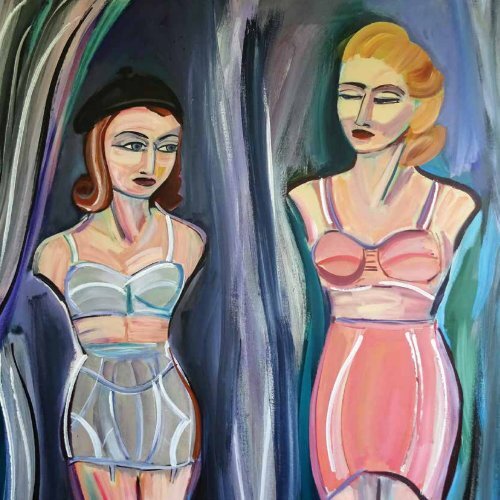SRGN_VickiV_Catalogue_42pp+4pp_PROOF_LowRes
Create successful ePaper yourself
Turn your PDF publications into a flip-book with our unique Google optimized e-Paper software.
LINGERIE TORSOS<br />
2004 Acrylic on canvas 122x107cm<br />
VICKI<br />
VARVARESSOS<br />
When Vicki Varvaressos enrolled in the National Art School in<br />
Darlinghurst, only a short distance from her childhood home<br />
of Bellevue Hill, It was like entering another world. In 1970<br />
Sydney’s inner city was commonly regarded as a slum. Her<br />
childhood had been spent in Bellevue Hill, a neighbourhood of<br />
large freestanding houses embedded in magnificent gardens.<br />
She was soon introduced to narrow streets with few trees,<br />
terrace houses, cramped flats, public drunkenness, street<br />
prostitution, and other open manifestations of poverty. But<br />
there was a vitality missing from suburbia. She soon moved<br />
to digs nearby and became one of the activists trying to save<br />
the city from the developers who saw derelict houses as an<br />
opportunity to build high rise luxury apartments and reshape<br />
the inner city away from bohemian grunge. She joined the<br />
Darlinghurst Residents Action Group, working with other artists<br />
who were making posters and other visual protests.<br />
At the National Art School, the overwhelming majority of students<br />
were women, but only the male students were treated with<br />
respect by both the institution and most of the teaching staff. The<br />
widespread assumption was that unless they were planning on<br />
becoming school teachers, the women students had enrolled in<br />
art as a faux bohemian finishing school before settling down as<br />
wives of either “real” artists or professional men.<br />
In Varvaressos’s memory most of the artists who were teaching<br />
at the National Art School were more concerned with their<br />
own professional careers and did not see the need to do<br />
much more than express mild approval at student efforts. The<br />
one exception was Peter Blayney. “He was one of the few<br />
who were actually professional, who took the job seriously,”<br />
Varvaressos recalls. “I remember Peter would talk to you, look<br />
at your work – and talk to you as though you were an artist,<br />
not just as though you were one of the female members of the<br />
class.” Blayney’s highly finished allegorical paintings, with their<br />
references to art historical precedents, bear no resemblance<br />
to the work his students produced. His importance to<br />
Varvaressos and other students he taught was the respect he<br />
gave to them, the suggestion that these early efforts may well<br />
be the first steps in a distinguished career. Years later in the<br />
mid-1980s, when she was teaching at the City Art Institute, she<br />
in turn became a similar influence on a younger generation of<br />
artists whose work looked nothing like her own.


